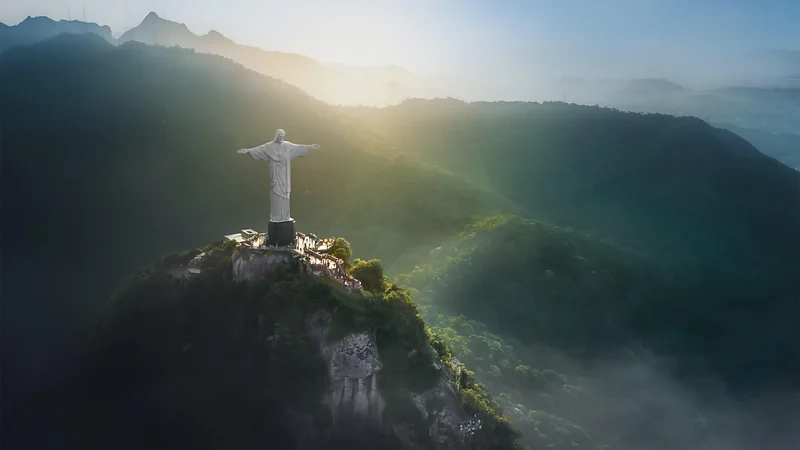Tijuca National Park: The fight to rewild the world's largest urban forest
After the forest was decimated by colonial plantations, an ambitious rewilding programme is now aiming to ensure the survival of Rio de Janeiro's ancient rainforest.

One minute I'm choked by fumes under a concrete overpass. Minutes later, I'm soaked in sweat, sticky with the respiration of a forest. Now, that's not something you feel in every city – especially one with more than six million inhabitants.
Rio de Janeiro might be known for its beaches, football and Carnival, but few realise that it contains the world's largest urban forest: the Tijuca forest.
Tijuca is no typical forest. First protected in 1861 – a decade before the first national park in the United States – Tijuca forest is a 40 sq km chunk of Atlantic Forest, a once-vast biome that covered 1,000,000 sq km of Brazilian coastline. Today, roughly 15% of the Atlantic Forest remains, decimated by sugarcane and coffee plantations as well as logging by the European colonists that first stepped on Brazil's shores in the 16th Century.
In Rio de Janeiro, the loss of Atlantic Forest over the next 200 years was nearly a death knell for the young settlement. Rivers that quenched the city dried up and drought was imminent. Nineteenth-century Emperor Peter II had a solution: bring back the forest. So in the 1860s, farmers and city dwellers living on forest land were expropriated and enslaved Africans were ordered to plant more than 100,000 trees. However, they didn't bring back many of the animal species that once thrived in the forest.
In 1967, the Tijuca forest was declared a national park divided into three non-contiguous sectors: Tijuca Forest west of the city centre; Carioca, where the world wonder Cristo Redentor statue is located; and Pedra Bonita and Gávea mountains overlooking the beach. Tijuca National Park has since become the country's most visited, with more than 3.5 million visitors annually.
"Picture in your mind just for a second Rio without the forest, just the bare mountains and the seas – Rio would not be the wonderful city anymore," said Fernando Fernandez, a professor of ecology at the Federal University of Rio de Janeiro and co-founder of conservation organisation Project Refauna.
But the Tijuca forest isn't just eye candy – it's a critical temperature regulator and source of freshwater for Brazil's second-largest metropolis. And according to Fernandez, the forest isn't healthy.
When you hike through Tijuca National Park, the forest looks like it's thriving. Trails leading to more than 30 waterfalls and climbs up iconic mountains like Pedra da Gávea and Pedra Bonita reveal lush flora with drooping vines, giant jackfruit splattered on the ground and cute capuchin monkeys picking apart bananas.
Where to go and what to do:
Travellers can visit all three sectors of Tijuca National Park via public transport, bike or taxi/Uber from Rio's South Zone.
Tijuca Forest: Hike to waterfalls, coffee plantation ruins, climb the city's highest point (Tijuca Peak) and try to spot Project Refauna's introduced species.
Pedra Bonita and Pedra da Gávea: Climb two of Rio's most popular mountains – Pedra Bonita and Pedra da Gávea – for views over the city.
Without them, the forest can't capture as much carbon – a necessity for slowing down climate change – and will become "a disturbed forest that is a mess of trees of every size".
In a healthy forest, tall trees should also intertwine overhead, providing a healthy forest canopy – but they currently aren't. "What tells you the Atlantic Forest is mature is that if you are standing in the forest, you can see another person 50 or 100m from you," he said.
The reason Tijuca's tall trees are struggling to spread is because the forest is empty of many of the seed-spreading animals that used to thrive there. "If you don't have the animals, you don't have the trees," said Catharina Kreischer, a researcher with Project Refauna.
Trees grow colourful, delicious fruit to attract hungry animals who then digest the seeds and defecate them out elsewhere, spreading the plant species across the forest, explained Kreischer. But many of the seed-spreading animals disappeared from this particular part of the forest when it was cleared and have never returned. That's why Project Refauna is bringing the fauna back to Tijuca – because a forest isn't just trees; it's also animals.
While other forest restoration projects around the world involve "rewilding", by reintroducing headline-driving predators like wolves or bears, Project Refauna prefers to start small. "Most people that think about introducing species think about endangered species," said Fernandez. "With Refauna, we purposely work with non-endangered species [that relocated elsewhere when the forest was cleared]."
Tijuca Forest used to be home to 33 large- and medium-sized species, including jaguars, tapirs and peccaries, but just 11 remain. Project Refauna could hypothetically reintroduce some of these animals, but many require a much larger area to hunt or are simply too dangerous to be dropped into the middle of a city. Instead, it's reintroducing species that are endemic to the forest, easy to work with and thrive elsewhere in Brazil.
In 2009, Project Refauna reintroduced red-rumped agoutis, a cat-sized rodent that had been hunted to extinction in Tijuca Forest but was still crawling around elsewhere in the city. Fifteen years later, I could see the project's impact during my visit.
After getting off the 301 bus at Praça Afonso Viseu, which is located directly at one of the park's main entrances, Kreischer and I walked into the park (entrance is free) and stopped alongside the main road to pick up a brown, apple-sized arara nut under a giant tree. "When I started my work at Refauna, I could actually see a lot more seeds, especially on the main road, than I do now," said Kresicher, who rolled up her trouser leg to display an agouti tattoo on her ankle. "Now when I walk in the forest, I see far fewer fruits and seeds rotting on the ground. This is a good indication that the agoutis are establishing themselves and are fulfilling their role."
We continued along earthen trails and past the gushing Cascatinha Taunay waterfall until we reached Titan, a gigantic yellow-footed tortoise introduced to the park by Project Refauna in 2020. As I approached his cage to take a photo, Titan had the look of bloody murder in his eyes and my heart pounded harder than I'd like to admit for such a slow-moving threat. Titan's violent nature meant that he had to be separated from his fellow tortoises, ending his bloodline – but that wasn't the only bad news.
Kreischer explained that like agoutis, tortoises are terrific seed dispersers since they eat almost anything and their slow digestive tracts allow them to defecate far from the parent plant. However, unlike agoutis, tortoises haven't been able to thrive in Tijuca Forest – of the 56 tortoises introduced, just 30 remain, as many have been killed by city dogs that invade the park.
Kreischer walked me to Project Refauna's headquarters where I met with a couple of researchers who were installing camera traps to try and catch domestic dogs who dig up and eat the tortoise eggs.
Project Refauna also had disappointing results with another one of its reintroduced species: howler monkeys. The organisation brought back the primates in 2015 – a century after they had vanished from the park. But of the seven reintroduced to the park, just two remain. The rest died from a yellow fever outbreak.
When asked whether the project was going well, Fernandez leaned in and responded honestly, "No."
Carbon count
The travel emissions it took to report this story were 0.00 metric tons of CO2e. Find out more about how we calculated this figure here.
The loss of the howler monkeys and tortoises were major setbacks, and there have been issues securing enough funding to keep the organisation going. But Fernandez is far from ready to give up.
Project Refauna reintroduced a fresh group of vaccinatedhowler monkeys in January and is forging ahead with its next species: the blue and yellow macaw. The plan is to continue working up the food chain all the way to ocelots (a medium-sized spotted wild cat), the largest predator that once lived here before Rio became the city it is today and that could theoretically survive in a forest of this size again.
"This is a project for decades," said Fernandez.
Saving a forest is slow work, so in the meantime, both Fernandez and Kreischer believe there's another way to help: by visiting the park, just as I did.
Hiking in the forest, soaking in its views and learning about its flora and fauna remind humans that this forest isn't just for Rio's recreation, it's vital for the city's survival. "The more people visit this forest, the more people enjoy this forest, the more protected the forest will be," said Fernandez.
-bbc







